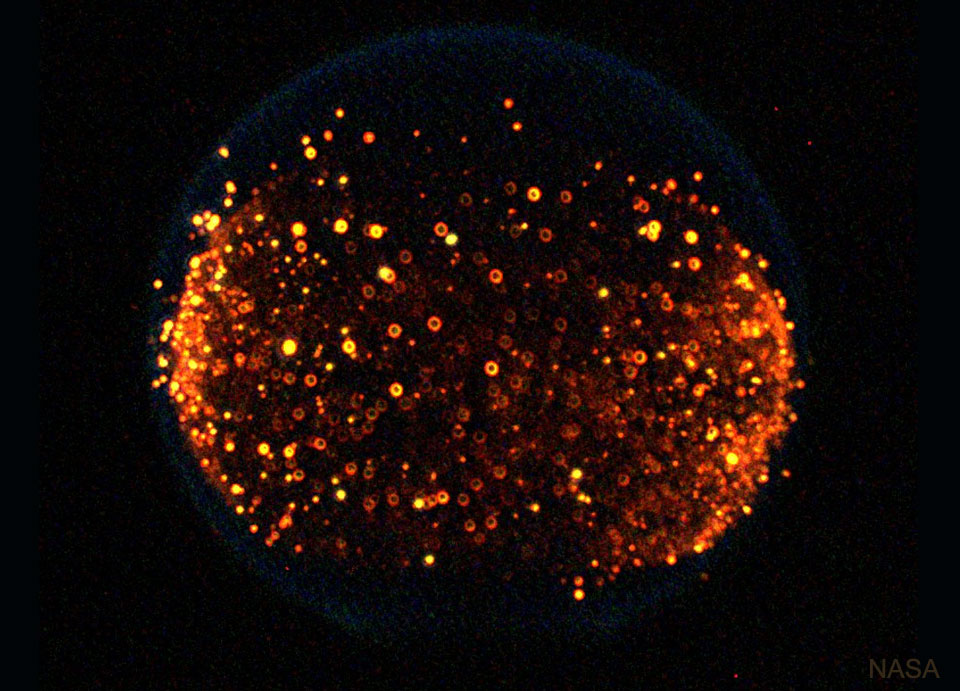10. August 2021
太空 ê 火

探索宇宙1!逐工會揀一幅無仝款 ê 影像抑是相片,𤆬你熟似咱這个迷人 ê 宇宙,閣有專業天文學者2為你3解說4。
- 原始文章:Fire in Space
- 影像來源:NASA
- 台文翻譯:An-Li Tsai (NCU)
[漢羅] 太空 ê 火
火 tī 太空看起來是按怎? 若是有 地球重力 ê 影響,加溫氣體 to̍h 會 peh-升、脹大,予火舌變做 淚珠形。 毋閣若是 tī 有 注空氣入去 ê 國際太空站 (ISS) 面頂 ê 微重力 環境,火舌 to̍h 會變做 球形。 火是愛一直提著酸素才會繼續燒。 毋閣 太空火舌 愛拄著無仝方向隨機浮 tī 太空 ê 酸素 分子才會繼續燒。 所以才會產生這个球包。 這張 tī ISS 燃燒集中架 翕 ê 影像,是 球形火舌內底包一簇一簇 高溫發光 ê 烏煙黗。 若是無酸素,比論講像 tī 太空按呢 真空 ê 狀況,火 to̍h 會隨花--去。 有足濟 kah 火 有關係 ê 化學反應攏足複雜 ê。 Tī 微重力 ê 環境 做試驗,毋若會當 幫贊人類 了解火,嘛會當知影按怎拍 火。
[POJ] Thài-khong ê hóe
Hóe tī thài-khong khòaⁿ--khí-lâi sī án-ná? Nā-sī ū Tē-kiû tiōng-le̍k ê éng-hióng, ka-ūn khì-thé to̍h ē peh-seng, tiùⁿ-tōa, hō͘ hóe-chi̍h piàn-chò lūi-chu-hêng. M̄-koh nā-sī tī ū chù khong-khì ji̍p-khì ê Kok-chè-thài-khong-chām (ISS) bīn-téng ê bî-tiōng-le̍k khoân-kéng, hóe-chi̍h to̍h ē piàn-chò kiû-hêng. Hóe sī ài it-ti̍t the̍h-tio̍h sng-sò͘ chiah-ē kè-sio̍k sio. M̄-koh thài-khong hóe-chi̍h ài tú-tio̍h bô-kâng-hong-hiòng sûi-ki phû-tī thài-khong ê sng-sò͘ hun-chú chiah-ē kè-sio̍k sio. Só͘-í chiah-ē sán-seng chit-ê kiû-pau. Chit-tiuⁿ tī ISS Jiân-sio chi̍p-tiong-kè hip--ê iáⁿ-siōng, sī kiû-hêng hóe-chi̍h lāi-té pau chi̍t-chhok-chi̍t-chhok ko-un hoat-kng ê o͘-ian-thûn. Nā-sī bô sǹg-sô, pí-lūn-kóng chhiūⁿ tī thài-khong án-ni chin-khong ê chōng-hóng, hóe to̍h ē sûi hoa--khì. Ū chiok-chōe kah hóe ū-koan-hē ê hòa-ha̍k hoán-èng lóng chiok ho̍k-cha̍p ê. Tī bî-tiōng-le̍k ê khoân-kéng chò chhì-giām, m̄-nā ē-tàng pang-chān jîn-lūi liáu-kái hóe, mā ē-tàng chai-iáⁿ án-ná phah-hóe.
[KIP] Thài-khong ê hué
Hué tī thài-khong khuànn-khí-lâi sī án-ná? Nā-sī ū Tē-kiû tiōng-li̍k ê íng-hióng, ka-ūn khì-thé to̍h ē peh-sing, tiùnn-tuā, hōo hué-tsi̍h piàn-tsò luī-tsu-hîng. M̄-koh nā-sī tī ū tsù khong-khì ji̍p-khì ê Kok-tsè-thài-khong-tsām (ISS) bīn-tíng ê bî-tiōng-li̍k khuân-kíng, hué-tsi̍h to̍h ē piàn-tsò kiû-hîng. Hué sī ài it-ti̍t the̍h-tio̍h sng-sòo tsiah-ē kè-sio̍k sio. M̄-koh thài-khong hué-tsi̍h ài tú-tio̍h bô-kâng-hong-hiòng suî-ki phû-tī thài-khong ê sng-sòo hun-tsú tsiah-ē kè-sio̍k sio. Sóo-í tsiah-ē sán-sing tsit-ê kiû-pau. Tsit-tiunn tī ISS Jiân-sio tsi̍p-tiong-kè hip--ê iánn-siōng, sī kiû-hîng hué-tsi̍h lāi-té pau tsi̍t-tshok-tsi̍t-tshok ko-un huat-kng ê oo-ian-thûn. Nā-sī bô sǹg-sô, pí-lūn-kóng tshiūnn tī thài-khong án-ni tsin-khong ê tsōng-hóng, hué to̍h ē suî hua--khì. Ū tsiok-tsuē kah hué ū-kuan-hē ê huà-ha̍k huán-ìng lóng tsiok ho̍k-tsa̍p ê. Tī bî-tiōng-li̍k ê khuân-kíng tsò tshì-giām, m̄-nā ē-tàng pang-tsān jîn-luī liáu-kái hué, mā ē-tàng tsai-iánn án-ná phah-hué.
[English] Fire in Space
What does fire look like in space? In the gravity on Earth, heated air rises and expands, causing flames to be teardrop shaped. In the microgravity of the air-filled International Space Station (ISS), however, flames are spheres. Fire is the rapid acquisition of oxygen, and space flames meet new oxygen molecules when they float by randomly from all directions -- creating the enveloping sphere. In the featured image taken in the ISS's Combustion Integration Rack, a spherical flame envelopes clusters of hot glowing soot. Without oxygen, say in the vacuum of empty space, a fire would go out immediately. The many chemical reactions involved with fire are complex, and testing them in microgravity is helping humanity not only to better understand fire -- but how to put out fire, too.
詞彙學習
| 漢羅 | POJ | KIP | 華語 | English |
|---|---|---|---|---|
| 國際太空站 | Kok-chè-thài-khong-chām | Kok-tsè-thài-khong-tsām | 國際太空站 | International Space Station (ISS) |
| 燃燒集中架 | Jiân-sio-chi̍p-tiong-kè | Jiân-sio-tsi̍p-tiong-kè | 燃燒集中架 | Combustion Integration Rack |
| 酸素分子 | sng-sò͘ hun-chú | sng-sòo hun-tsú | 氧氣分子 | oxygen molecules |
| 烏煙黗 | o͘-ian-thûn | oo-ian-thûn | 煤煙 | soot |
| 火舌 | hóe-chi̍h | hué-tsi̍h | 火焰 | flames |
| 微重力 | bî-tiōng-le̍k | bî-tiōng-li̍k | 微重力 | microgravity |
| 淚珠形 | lūi-chu-hêng | luī-tsu-hîng | 淚珠形 | teardrop shape |